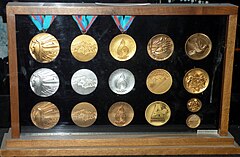Zimowe Igrzyska Olimpijskie 1988
| Ten artykuł od 2021-03 wymaga zweryfikowania podanych informacji. |
 | |
| Stolica igrzysk | |
|---|---|
| Liczba ekip | 57 |
| Liczba sportowców | 1423 |
| Liczba konkurencji | 46 w 6 dyscyplinach |
| Otwarcie | |
| Oficjalne otwarcie | |
| Zamknięcie | 28 lutego 1988 |
| Przysięga olimpijska | |
| Znicz olimpijski | Robyn Perry |
| Stadion | McMahon Stadium |
XV Zimowe Igrzyska Olimpijskie w 1988 rozegrane zostały w Calgary, największym mieście kanadyjskiej prowincji Alberta. W dniach 13 – 28 lutego w zmaganiach sportowych zmierzyło się 1423 zawodników (w tym 1110 mężczyzn i 313 kobiet) z 57 krajów. Zadebiutowali przedstawiciele 6 reprezentacji: Antyli Holenderskich, Fidżi, Guamu, Gwatemali, Jamajki i Wysp Dziewiczych Stanów Zjednoczonych. Igrzyska otworzyła gubernator Kanady Jeanne Sauvé.
Decyzja o wyborze Calgary jako miasta organizatora zapadła 30 września 1981 roku. O organizację tych igrzysk zabiegały także: Falun (Szwecja) oraz Cortina d’Ampezzo (Włochy). Były to pierwsze zimowe igrzyska w Kanadzie. Wcześniej, w 1976 roku, organizatorem letnich igrzysk był Montreal.
W Calgary rozgrywane były nowe konkurencje: konkursy drużynowe w skokach narciarskich oraz kombinacji norweskiej, zaś w narciarstwie alpejskim zadebiutował supergigant oraz po 40 latach do programu igrzysk wróciła kombinacja alpejska. Rozegrano również trzy konkurencje pokazowe: curling, narciarstwo dowolne, oraz short track. Ponadto rozegrano również zawody w narciarstwie dla niepełnosprawnych.
Dyscypliny olimpijskie
- biathlon
- bobsleje
- curling (sport pokazowy)
- hokej na lodzie
- łyżwiarstwo
- narciarstwo
- narciarstwo alpejskie (debiut supergiganta i powrót do programu IO po 40 latach kombinacji alpejskiej)
- narciarstwo klasyczne
- biegi narciarskie
- skoki narciarskie (debiut konkursu drużynowego)
- kombinacja norweska (debiut konkursu drużynowego)
- narciarstwo dowolne (jazda po muldach – sport pokazowy)
- saneczkarstwo
Państwa biorące udział w XV Zimowych Igrzyskach Olimpijskich
|
|
Rozgrywane dyscypliny
Uczestnicy zimowych igrzysk w Calgary w 1988 roku rywalizowali w 6 dyscyplinach sportowych i 46 konkurencjach.
 Biathlon
Biathlon Biegi narciarskie
Biegi narciarskie Bobsleje
Bobsleje Hokej na lodzie
Hokej na lodzie Kombinacja norweska
Kombinacja norweska Łyżwiarstwo figurowe
Łyżwiarstwo figurowe Łyżwiarstwo szybkie
Łyżwiarstwo szybkie Narciarstwo alpejskie
Narciarstwo alpejskie Saneczkarstwo
Saneczkarstwo Skoki narciarskie
Skoki narciarskie
Pokazowe
 Curling
Curling Narciarstwo dowolne
Narciarstwo dowolne Short track
Short track- Narciarstwo niepełnosprawnych
Klasyfikacja medalowa
| Lp. | Kraj | Złoto | Srebro | Brąz | Razem |
|---|---|---|---|---|---|
| 1 | 11 | 9 | 9 | 29 | |
| 2 | 9 | 10 | 6 | 25 | |
| 3 | 5 | 5 | 5 | 15 | |
| 4 | 4 | 1 | 2 | 7 | |
| 5 | 4 | 0 | 2 | 6 | |
| 6 | 3 | 5 | 2 | 10 | |
| 7 | 3 | 2 | 2 | 7 | |
| 8 | 2 | 4 | 2 | 8 | |
| 9 | 2 | 1 | 3 | 6 | |
| 10 | 2 | 1 | 2 | 5 |
Podczas zimowych igrzysk olimpijskich w Calgary, srebrnym medalem olimpijskim nagrodzeni zostali zdobywcy wszystkich ośmiotysięczników Reinhold Messner i Jerzy Kukuczka. Messner odmówił przyjęcia wyróżnienia.
Polscy reprezentanci
Spośród 33 uczestniczących w igrzyskach Polaków, największą grupę stanowili hokeiści, których wystąpiło dwudziestu trzech. Jednak żaden z naszych reprezentantów nie zdobył medalu. Najbliżej znalezienia się w pierwszej trójce byli Grzegorz Filipowski w przejeździe solistów w łyżwiarstwie figurowym oraz Erwina Ryś-Ferens w łyżwiarstwie szybkim, która w wyścigu na 3000 metrów była na piątym miejscu. Ryś-Ferens zajęła również siódme miejsce w wyścigu na 1500 metrów.
Media użyte na tej stronie
Olympic Rings without "rims" (gaps between the rings), As used, eg. in the logos of the 2008 and 2016 Olympics. The colour scheme applied here pertains to the 2016 Olympics in Rio de Janeiro.
Olympic Rings without "rims" (gaps between the rings), As used, eg. in the logos of the 2008 and 2016 Olympics. The colour scheme applied here pertains to the 2016 Olympics in Rio de Janeiro.
Autor: https://phabricator.wikimedia.org/diffusion/GOJU/browse/master/AUTHORS.txt, Licencja: MIT
An icon from the OOjs UI MediaWiki lib.
Autor: https://phabricator.wikimedia.org/diffusion/GOJU/browse/master/AUTHORS.txt, Licencja: MIT
An icon from the OOjs UI MediaWiki lib.
Flag of Canada introduced in 1965, using Pantone colors. This design replaced the Canadian Red Ensign design.
Autor: Scroch, Licencja: CC BY-SA 3.0
Flag of Bulgaria (1971-1990). Flag of Bulgaria with Bulgarian coat from 1971.
Łatwo można dodać ramkę naokoło tej grafiki
Official flag used by the Fédération Internationale de Football Association (FIFA) to represent Chinese Taipei in association football matches. Also used at the Olympics from 1986 to 2010.
Flaga Finlandii
The flag of Guam, courtesy an e-mail from the author of xrmap. Modifications by Denelson83.
Autor: Pedro A. Gracia Fajardo, escudo de Manual de Imagen Institucional de la Administración General del Estado, Licencja: CC0
Flaga Hiszpanii
The Flag of India. The colours are saffron, white and green. The navy blue wheel in the center of the flag has a diameter approximately the width of the white band and is called Ashoka's Dharma Chakra, with 24 spokes (after Ashoka, the Great). Each spoke depicts one hour of the day, portraying the prevalence of righteousness all 24 hours of it.
Flag of Jamaica. “The sunshine, the land is green, and the people are strong and bold” is the symbolism of the colours of the flag. GOLD represents the natural wealth and beauty of sunlight; GREEN represents hope and agricultural resources; BLACK represents the strength and creativity of the people. The original symbolism, however, was "Hardships there are, but the land is green, and the sun shineth", where BLACK represented the hardships being faced.
Variant version of a flag of Japan, used between January 27, 1870 and August 13, 1999 (aspect ratio 7:10).
Flag of the Socialist Federal Republic of Yugoslavia (1946-1992).
The design (blazon) is defined in Article 4 of the Constitution for the Republic of Yugoslavia (1946). [1]
Flag of the Socialist Federal Republic of Yugoslavia (1946-1992).
The design (blazon) is defined in Article 4 of the Constitution for the Republic of Yugoslavia (1946). [1]
Flag of Liechtenstein
Flag of New Zealand. Specification: http://www.mch.govt.nz/nzflag/description.html , quoting New Zealand Gazette, 27 June 1902.
Flag of Portugal, created by Columbano Bordalo Pinheiro (1857-1929), officially adopted by Portuguese government in June 30th 1911 (in use since about November 1910). Color shades matching the RGB values officially reccomended here. (PMS values should be used for direct ink or textile; CMYK for 4-color offset printing on paper; this is an image for screen display, RGB should be used.)
Flag of Romania, (21 August 1965 - 22 December 1989/officialy 27 December 1989).
Construction sheet of the Flag of Romania as depicted in Decree nr. 972 from 5 November 1968.
- l = 2/3 × L
- C = 1/3 × L
- S = 2/5 × l
Flag of Romania, (21 August 1965 - 22 December 1989/officialy 27 December 1989).
Construction sheet of the Flag of Romania as depicted in Decree nr. 972 from 5 November 1968.
- l = 2/3 × L
- C = 1/3 × L
- S = 2/5 × l
The flag of Navassa Island is simply the United States flag. It does not have a "local" flag or "unofficial" flag; it is an uninhabited island. The version with a profile view was based on Flags of the World and as a fictional design has no status warranting a place on any Wiki. It was made up by a random person with no connection to the island, it has never flown on the island, and it has never received any sort of recognition or validation by any authority. The person quoted on that page has no authority to bestow a flag, "unofficial" or otherwise, on the island.
Flag of Italy from 1946 to 2003, when exact colors were specified.
Pictograms of Olympic sports - Biathlon
Pictograms of Olympic sports - Cross country skiing
Pictograms of Olympic sports - Bobsleigh
Pictograms of Olympic sports - Ice hockey
Pictograms of Olympic sports - Nordic combined
Pictograms of Olympic sports - Figure skating
Pictograms of Olympic sports - Speed Skating
Pictograms of Olympic sports - Alpine skiing
Pictograms of Olympic sports - Luge
Pictograms of Olympic sports - Ski jumping
Pictograms of Olympic sports - Curling
Pictograms of Olympic sports - Freestyle skiing
Autor: B1mbo, Licencja: CC BY-SA 2.5
Drawing of a gold medal, based on Olympic rings.svg.
Autor: B1mbo, Licencja: CC BY-SA 2.5
Draw of a silver medal, based in Olympic rings.svg.
- The joining of the rings is not correct drawn.
Autor: B1mbo, Licencja: CC BY-SA 2.5
Drawing of a bronze medal, based on Olympic rings.svg.
Flag of South Korea from 21 February 1984 to October 1997, when the exact colors were specified into their shades. Sources: https://www.britannica.com/topic/flag-of-South-Korea, http://www.christusrex.org/www3/fotw/flags/kr_hist.html, http://fotw.fivestarflags.com/kr_hist.html, http://destinationsouthkorea.weebly.com/flag-history.html http://www.law.go.kr/lsInfoP.do?lsiSeq=51832&ancYd=19840221&ancNo=11361&efYd=19840221&nwJoYnInfo=N&efGubun=Y&chrClsCd=010202#0000.
Pictograms of Olympic sports - Short track speed skating
Autor: Resolute, Licencja: CC BY-SA 3.0
A set of medals from the 1988 Winter Olympics on permanent display at the Pengrowth Saddledome in Calgary.













































































